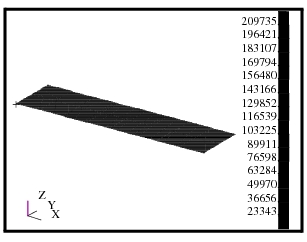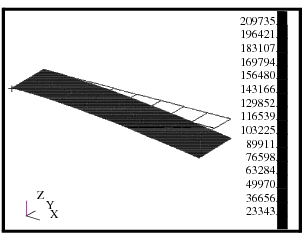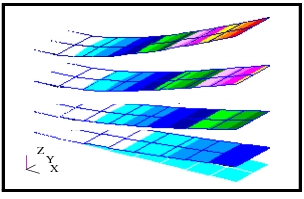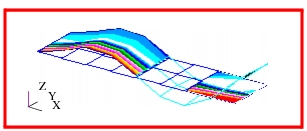XXXXXXXXXXXXXXXXXXXXXXXXXXXXXXXXXXXXXXXXXXXXXXXXXXXXXXXXXXXXXXXXXXXXXXXXXXXXXXXXXXXXXXXXXXXXXXXXXXXXXXXXXXXXXXXXXXXXXXXXXXXXXXXXXXXXXXXXXXXXXXXXXXXXXXXX''"> 5.5 Examples of Usage
The following are some typical scenarios for usage of the Fringe plot tool. These instructions assume that the Action is set to Create and the Object is set to Fringe unless otherwise specified.
Create a Simple Static Fringe Plot
1. From the Select Results form (left most icon) select the Result Case from the first listbox. If more than one subcase exists for a Result Case, turn the Abbreviate Subcases toggle OFF and then select the Result Case. | |
2. Select the Fringe Result from the next listbox. | |
3. (Optional) If the selected result has more than one layer associated with it, select the layer using the layer Position button. | |
4. (Optional) If the result is a vector or tensor, select a resolved scalar results value from the results Quantity pull-down menu (such as von Mises stress or Magnitude displacement). | |
5. Press the Apply button with the Animate toggle OFF.  Figure 5‑1 Fringe Plot of von Mises Stress
on Cantilever Plate. | |
Animate a Static Fringe Plot
1. From the Select Results form (left most icon) select the Result Case from the first listbox. | |
2. Select the Fringe Result from the next listbox. | |
3. (Optional) If the selected result has more than one layer associated with it, select the layer using the result Position button. | |
4. (Optional) If the result is a vector or tensor, select a resolved scalar results value from the results Quantity pull-down menu (such as von Mises stress or Magnitude displacement). | |
5. Turn the Animate toggle ON. | |
6. Press the Animation Options icon button. | |
7. Change the Animate By option pulldown menu to Ramp. | |
8. Press the Apply button. | |
Put a Fringe on a Deformed Plot
1. Create a deformation plot and make sure it is posted to the current viewport. See Deformation Plots, 1 for an explanation of deformation plot creation. | |
| |
3. Press the Display Attributes icon button. | |
4. Turn ON the Show on Deformed toggle. | |
5. (Optional) If more than one deformation plot exists and is posted to the viewport, you can optionally specify on which deformation plots to display the fringe plot. This is done under the Target Entities option. Otherwise the Fringe plot will show on all Deformation plots posted. | |
6. Press the Apply button with the Animate toggle OFF.  Figure 5‑2 Fringe Plot of von Mises Stress
on Deformed Cantilever Plate. | |
Display a Transient Fringe Animation
1. From the Select Results form (left most icon) select the Result Cases (time steps) from the first listbox that you wish to include in the transient animation. You must select more than one. Use the mouse and the control key to select discontinuous selections or the shift key to select continuous selection. You can also use the Select button when the Result Cases are being displayed in abbreviated form to filter and select the subcases (time steps) you want. In abbreviated form the Result Case name will only appear in the listbox as the name with number of subcases (time steps) selected, (i.e., Load Case 1, 6 of 41 subcases). | |
2. Select the Fringe Result from the next listbox. | |
3. (Optional) If the selected result has more than one layer associated with it, select the layer from the result Position pull-down menu. | |
4. (Optional) If the result is a vector or tensor, select a resolved scalar results value from the results Quantity pulldown menu (such as von Mises stress or Magnitude displacement). | |
5. Turn the Animate toggle ON. (If the Animate toggle is OFF then the resulting plot will simply plot up a maximum plot of all selected Result Cases and will not animate.) | |
6. Press the Animation Options icon button. | |
7. Select a Global Variable (time) to Animate By. Make any other optional modifications you want. | |
8. Press the Apply button. This method also works with load steps, frequency steps, or simply with multiple load cases that you may wish to animate.  Figure 5‑3 Exaggerated Transient Animation of Displacements with Fringe Superimposed on Deformed Shape. | |
Save a Fringe Plot
| |
2. Before pressing the Apply button to create a plot or animation, press the Plot Options icon button. | |
3. Type a name in the Save Fringe Plot As databox. | |
4. Then press the Apply button. The plot is now saved under a specific name which can be recalled (posted/unposted) graphically when desired. | |
Display Multiple Fringe Plots in the Current Viewport
1. Set up the first fringe plot as explained in the previous examples, but do not press the Apply button. | |
2. (Optional) You will most likely have to select target entities so as not to overlap fringe plots. | |
| |
4. Repeat this process for as many fringe plots as necessary. To put up multiple fringe plots in different viewports, simply make the viewport of interest active by clicking the mouse in its border and following the same procedure. An active viewport has a red border around the graphics.  Figure 5‑4 Two Fringe Plots Targeting Certain Elements,
One on the Undeformed Shape and One on the Deformed Shape. | |
Modify a Fringe Plot or Animation
1. Set the Action to Modify with the Object set to Fringe. | |
2. Select an existing fringe plot using the Existing Fringe Plots button. | |
3. Change results, target entities, display attributes, plot or animation options as required. | |
4. Press the Apply button at any time to see the results of your modifications. | |
Display Multiple Animations in the Current Viewport
| |
2. (Optional) Set the Action to Post and the Object to Plots. Post the plots to the viewports that you want if they are not already posted. They can be any plot type that supports animation. | |
3. Set the Action to Create and the Object to Animation. One by one, select the posted plots that you wish to animate from the top listbox and modify their animation method if necessary. This is done by pressing the Update Tool button. | |
4. Press the Apply button. See Animation, 1 for more details on this method. | |




